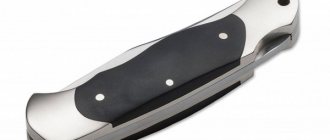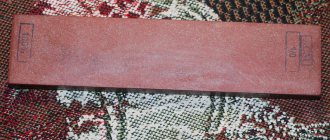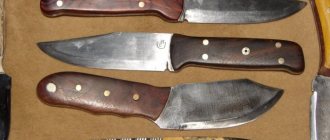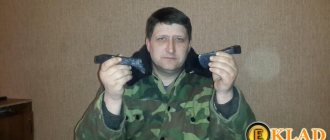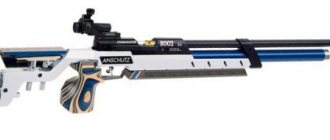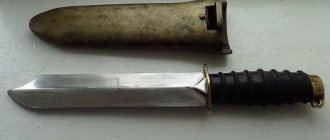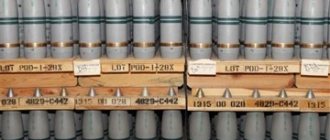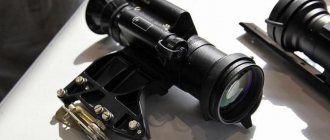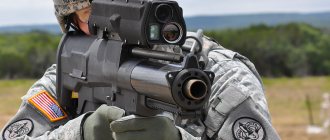The best models from well-known manufacturers and related options
The most valuable are the guns from Fiskars and Hackman.
They are found on sale much less frequently and are expensive - up to 20 thousand rubles. 1 of 2
puukko from Roselli
puukko from Marttiini
Those interested in puukko usually do not ignore the leuku, a larger Scandinavian hunting knife. This type of implement can be found at Martini and Roselli
Finnish Roselli
Finnish puukko Roselli knives are known to weapon lovers all over the world, as they differ in:
- High quality steel. For blades, use carbon Krupp W75, high carbon UHC, Roselli Wootz or Damascus. They are sharpened by hand, and the blade can not only cut paper, but also shave.
- Comfortable handles made of Karelian birch. They are well polished, impregnated with linseed oil, and heat treated. Thanks to this, the knife fits well in the hand, does not slip, and does not get cold. And the handle remains durable, despite the active use of the product in any conditions. The butt plate is usually rounded, that is, the gun can be held with a “Finnish grip” with the emphasis on the palm.
- Sheath made of durable leather. Inside there is a plastic cover that prevents the blade from damaging the base material. A convenient suspension makes carrying the gun hassle-free.
Watch the video about Finnish knives from Roselli:
The length of the puukko blade from Roselli is 85-102 mm, the handle is 110-125 mm. These knives are well balanced, which also makes them easier to use. You can buy a gun for 6-11 thousand rubles, there are copies priced at 60 thousand rubles.
Puukko and leukko
Finnish knives puukko and leukko are not exactly the same thing, although the latter is called by some a variant of puukko. And yet leuku has its own characteristics:
- Larger size. The length of its blade is 13-21 cm, width – 3.5 cm. The handle of the weapon is significantly shorter than the cutting component.
- A different blade shape. Leukko also has a straight spine and a raised blade line. But, unlike the puukko, the blade expands slightly in the area between the base and the tip, more precisely in the place where the sharp edge changes direction.
Leuku are produced by the same companies as the famous puukko models, although they originate from Lapland.
Martini big
Finnish puukko knives of the Martini Big Lynx series are one of the popular and inexpensive varieties of tools of this type, released for the 110th anniversary of the founding of the company. The blade has a length of 11 cm and a traditional shape, made of X46Cr13 steel with a hardness of HRC 56-57.
Marttiini Big Lynx
The handle of the knife is made of Karelian birch, its size is 12.5 cm. This part is very ergonomic, thanks to the recess for the finger at the base. The backplate is slightly bent downwards, which provides an even more secure hold of the tool in the hand.
The weapon comes with a leather sheath. They have an interesting shape - the tip is raised, there is a tassel-type detail on it. Closer to the entrance of the scabbard there is an image of the founder of the company and its logo. The cost of the gun is 5-7 thousand rubles.
Puukko is a knife that is convenient for many and beautiful in its simplicity, but sometimes you need to get used to it. When choosing, you should be guided not only by the reviews of others, but also by your own feelings. And, of course, it is better to buy a weapon from a well-known company so that it serves for a long time and does not lose its qualities.
Recommendations
The price of replica NKVD knives on the modern market ranges from 150-200 dollars (9-12 thousand rubles). The final cost is affected by age, equipment and material of manufacture. Early copies are valued higher, as they are considered to closely imitate the original finca. Initially, the blade in question belonged purely to specialized military weapons. Now such products are usually positioned as collectible or souvenir exhibits. It is recommended to purchase the original in the presence of an experienced antiquarian. It will help not only determine the authenticity of the model, but also its real value.
Is it possible to make a Finnish NKVD knife 1935 with your own hands?
The product can be made with your own hands so that you get an NKVD Finnish knife from 1935: you need to have a sheet of good steel, for example, grade 95X18, for the handle - a wooden block, and the guard and pommel are made from pieces of brass. You will need a set of discs of different diameters and with belts of different abrasiveness, a vice, and welding. The whole process consists of several stages:
- A drawing is made on paper or cardboard, possibly in two projections.
- On its basis, a cardboard template of a blade with a shank is cut out.
- It is fixed on a steel sheet, outlined and the workpiece is cut out along the lines using a disk machine.
- It is leveled using a flat grinder.
- Using a disk, draw a valley along the butt.
- The runs are made on a large disk with a diameter of 40 cm using a coarse 40-N abrasive.
- The next stage is hardening the blade in a forge, followed by cooling in oil and tempering.
- The bevels and blade are treated with a finer grit disc to level and polish.
- The final polishing of the blade is carried out first on a disk with a 4-N fine abrasive tape, and then on felt and GOI paste.
- The finished guard and butt are processed on a milling machine so that they fit the size of the blade and tang.
- The working part of the blade is wrapped with masking tape.
- A polished guard is placed on the shank.
- Holes are made in it for fastenings for a rod with a thread for a nut; it can also be welded.
- To make the handle, a birch block is turned and polished.
- A hole is made in it with a diameter corresponding to the thickness of the shank.
- In a small container, mix epoxy resin with hardener.
- The composition is coated with the place where the blade connects to the guard, the rest of the liquid is poured into the hole in the handle blank.
- The shank is also inserted there; its threaded tip should stick out from the other side of the wooden block.
- A nut is screwed onto it to secure the structure.
- The nut and pin are covered with a brass cap, which will be held in place by the epoxy mixture.
- The knife is placed in a vice and left to dry for a day.
- The handle is ground on a Grinder machine using sandpaper.
- To ensure smoothness, it is sanded by hand, clamped in a vice.
- The pommel is polished, including using GOI paste.
- The wooden part of the handle is treated with beeswax.
Watch the video of the complete production of the “NKVD Finka” knife:
Equipment
Buy the original Finnish NKVD knife, which came with the following set:
- The NKVD weapon itself with a red star had several modifications. For example, today there are several models of the original gun, which differ in the type of material and color of the handle;
- sheath. They were made only from dark-colored leather with a high level of hardness. Modern modifications may have a light-colored sheath. They are easily attached to your belt using a button.
What prompted the creation of scout knives?
The emergence of various types of firearms and equipment gradually relegated knives to the background, and this clearly affected the equipment of the Soviet troops, and in the most unfavorable way.
It became characteristic that by the 40s of the last century (or rather, during the period of hostilities between the Soviet Union and Finland in 1939), there was no standard knife for equipping a Soviet soldier (the bayonet that was attached to the Mosin rifle does not count: it was intended only for stabbing wounds). At the same time, the soldiers certainly needed an assistant: to cut bread, trim wood, cut rope and for many other needs, not excluding, of course, one of the main functions - self-defense, protection from the enemy.
The direct opposite was the enemy’s combat arsenal - Finnish soldiers, especially those who went on reconnaissance missions, had to have edged weapons.
The leadership of the Soviet Army, taking into account the unpleasant results of military clashes with the Finns for our side, came to the conclusion that soldiers, in particular those performing reconnaissance operations, needed to strengthen their combat arsenal. Consequently, it was decided to add one more component - a special reconnaissance knife, and the blade, which was used by the enemy, became a completely suitable idea for the development of the first Soviet reconnaissance knife, HP-40 (the digital indicator in the stamp indicates the year of manufacture - 1940).
Myths and reality
At the official level, the knife in question was not accepted for service, but was issued as clothing allowance. In 1940, in V. Volkov’s textbook “Combat Sambo,” one of the chapters was devoted to techniques for handling a Finnish knife. The production of Vachin finca at the Trud plant continued until the end of the 70s of the last century. The bladed weapons in question were used by NKVD and KGB officers during and after World War II. Like most things related to the State Security Committee, this product is also overgrown with secrets and myths. One of the legends spoke of a secret ballistic knife capable of firing a blade, other stories mentioned mercury throwing modifications.
Source
Design Features
For any bladed weapon, the main characteristic is the effectiveness of practical use. The finka is precisely the kind of weapon that can be both effective in combat and useful in everyday life. The blade of the traditional Finnish version is short and pointed on one side. However, this blade length makes it easy to use the knife for cutting branches and sharpening stakes. The product is very convenient as a kitchen utensil and can be used for cutting game. The blade is equipped with a thick spine, which allows you to apply additional physical force. The block or handle of the finka can withstand a blow from a log or a hammer to the butt.
For the manufacture of knives, weapon steel with a hardness of 58 units on the Rockwell scale is usually used. A Finnish hunting knife, made using traditional ancient technology by Finnish blacksmiths, is made from a worn-out scythe. The metal in this case is soft and ductile, amenable to cold forging. The manufacturing technology of traditional Puukko-Finnish knives was as follows:
- worn-out braids are collected in a bag (2-3 pcs.);
- when heated, the package is forged until monolithic bars are obtained;
- the finished bars are riveted into narrow thin metal strips;
- then pieces of steel are cut to fit the size of the blade;
- the strip is forged and turned to the shape of the blade and shank;
- the handle is mounted on the blade.
Today, for the manufacture of various versions of Finnish knives, high-carbon steel is mainly used, where nickel and chromium are present as alloying additives. Nickel increases the metal's resistance to corrosion, and chromium makes the material more resistant. In ancient recipes for making Finnish knives, they tried to use durable steel. Today, the edged weapons market is dominated by cheap grades of steel, which are used for the mass production of knives of dubious quality.
High-quality steel allows the blade to maintain its sharpness for a long time. Proper and competent care of the blade will prevent rust from occurring.
What is so special about the NKVD Finnish knife?
The NKVD Finnish knife or any other knife belonging to this category is known for its practicality and versatility. Products mainly have fixed blades, but there are also folding models. Finka differs from other knives:
- small sizes - 22-24.7 cm;
- the presence of a stop or S-shaped guard;
- a narrow blade with a beveled spine, 10.6-12.5 cm long;
- valleys running parallel to the blunt part of the part;
- a rounded or slightly curved handle with a non-slip surface and a mushroom-shaped pommel.
A traditional knife differs from a Finnish knife in that it is designed to solve narrow problems. Finnish, despite its small size, is suitable for self-defense, use at home, fishing or hunting. Design features make it safer for the owner.
The Finnish knife looks like a military weapon, although in most cases it is not. His most famous replicas belong to the category of tourist, hiking or gift items.
Blade dimensions, handle
Drawing
The dimensions of the Fink knife vary from 22 cm to 24.7 cm. The main parameter is the length of the blade, which for the classic model is 12.5 cm, but can be less - up to 10.6 cm.
The width of the part should be no more than 2 cm, and the thickness - up to 0.4 cm. This is a characteristic feature of the weapon - a narrow and short blade with a thin tip. The part is of the clip point type, that is, it has a bevel on the butt. Or is he straight? There are valleys along the butt on both sides, making the blade lighter and more maneuverable.
The weapon has a guard or, at a minimum, a limiter that prevents your hand from slipping onto the blade. Models with a bolster can be held with a Finnish grip, that is, resting on the palm. Some weapons have a “heel” in front of the guard - an unsharpened section of the blade. Thus, with a direct grip, the index finger lies on the blade, but the skin cannot be injured. But the direction of the cut is perfectly controlled.
Drawing
The handle of the product was originally wooden. But modern models use bakelite and other synthetic materials. The shape of the part is round, sometimes tapering towards both edges or thickening towards the end. The pommel comes in the form of a fungus and can be made of brass or another metal alloy.
Materials
Previously, the blades of Finnish knives were made from 2-3 worn braids. They were formed into a package, that is, folded, heated, and forged into a monolithic piece. Sheets were then made from it, blanks were cut out, processed and mounted on a wooden handle.
Modern replica guns are made of high-carbon steel with a hardness of 58 HRC, with the addition of nickel and chromium. They are durable, remain sharp for a long time, and with good care are not subject to corrosion. There are also cheaper models with stainless steel blades.
The handles of souvenir knives are made of Karelian birch, animal horn, with cupronickel inserts and leather additives. The same part can be created from hornbeam with brass, a polymer material.
Is it a bladed weapon?
In the photo there are Finnish knives that are freely available (not being weapons).
The original Finnish knives are edged weapons (KW), as they have the appropriate technical parameters, which are specified in GOST R 51215-98:
- handle with finger grooves;
- blade length is more than 9 cm;
- butt thickness from 0.24 cm;
- the angle of convergence of the butt and blade is less than 70 degrees;
- the presence of a stop-limiter.
But it is difficult to find such a weapon for sale, and it is very expensive. To own, you must obtain permission. And Finns that are freely available are not XO, since their size and characteristics do not fall under this definition. Such knives are classified as tourist, camping, or souvenir knives, as stated in the certificates attached to them.
LiveInternetLiveInternet
I'll start the review with the legendary HP 40.
Dimensions: total length: 290 mm; blade length: 152 mm; Blade width at heel: 25 mm. Description: Straight steel blade, single-edged, without fullers, double-edged combat end. The handle is wooden, black, solid with a straight back and a wavy belly. The crosspiece is steel, short, flat, with ends bent in different directions. The scabbard is wooden, painted black, with a metal device consisting of a mouth and a tip. A leather suspension is attached to the mouth. Historical background: In the early to mid-1930s, legislation regarding the circulation of bladed weapons was tightened in the RSFSR; a direct ban on the manufacture, storage, sale and carrying of Finnish knives appeared in the Criminal Code. At the same time, NKVD employees have been receiving, as a special tool, since 1935 a Finnish knife (in some documents a “Norwegian” or “Swedish type knife”), manufactured in several varieties (formerly a factory of the industrialist Kondratov) in the village of Vacha, Nizhny Novgorod region. The basis of the “NKVD knife” was a copy of a Swedish knife produced by P. Holmberg, which was banned as a “Finnish knife.” The knife was characterized by either a straight spine or a spine with a characteristic bevel - “pike”, fullers, and a Finnish type of handle head. A distinctive feature from the Finnish puukko was the developed curved guard, often S-shaped. An unsharpened heel was left on the blade in front of the guard, so that in some grips the index finger could be transferred to the blade. The handle was made of carbolite. The knife was not officially in service, but was issued as clothing allowance. From the 1930s to the end of the 1970s, he completed at least 6 large orders for similar knives. The Soviet-Finnish War revealed shortcomings in the Red Army's armament. Among other conclusions, in 1940 the models of authorized edged weapons were revised, in particular, a new army knife was adopted for service. The alleged prototypes of the Soviet army knife are: • a Finnish uniform bayonet-knife of the 1919 model, designed by the artist Akseli Gallen-Kallela and produced by Fiskars - an eclectic model that combines a blade with a lowered butt line, fullers and a developed heel, a large S-shaped guard , a saber handle with a metal back, an all-metal sheath that follows the curve of the puukko sheath, a large lanyard brush, borrowed from long-bladed weapons; • Finnish scout knives (partiopuukko) - knives designed for boy scout organizations in different countries, with clear signs of American traditions - a double-sided (less often one-sided) guard stop, a blade with a predominantly beveled spine, a narrow or wide fuller. Scout models, purchased with personal funds, enjoyed some popularity among soldiers of the regular Finnish army and representatives of volunteer organizations. None of the models can be called the direct ancestor of the HP-40, although all elements of the knife, design and manufacturing technology are easily recognizable in the prototypes. The production of HP-40 was established in the village of Vacha and at the Zlatoust Tool Plant No. 259 named after. V. I. Lenin (ZiK). The vast majority of the total number of army knives were produced in Zlatoust. Peak production during wartime occurred in 1942-1943. In 1942, the Zlatoust plant produced military knives: 261,000 pieces, in 1943 - 388,000 pieces (of which in the first half of the year - 271,000, in the second - 117,000 pieces). In addition to serial factory production, the practice of ordering knives from handicraft enterprises and manufacturing them in front-line workshops was widespread. In this regard, numerous types of knives are known that outwardly resemble the standard army knife of the 1940 model, but differ in design and the materials used. Handicraft modifications and decorations of the statutory knife were also often made. Particularly popular was the replacement of a solid wooden handle with a composite one made of different materials, for example, plexiglass. The adoption of the 1940 model knife into service was caused by the appearance in the army of relatively short types of small automatic weapons (primarily submachine guns), which did not have a bayonet attached to the barrel. The army knife was issued to submachine gunners of the Red Army, which is why the knife is sometimes called the “submachine gunner’s knife.” Techniques of working with a “short Finnish or Norwegian knife” were added to the Sambo combat system by V.P. Volkov in 1940. By 1941, knife operations were included in the “Guide to Preparation for Hand-to-Hand Combat of the Red Army.” The richest and most developed system for using combat knives was the close combat system developed by N. N. Simkin and the Moscow Institute of Physical Education, published in the brochure “Close Combat” (M.: “Physical Culture and Sport”, 1944). The knife, like firearms, was entered in the Red Army soldier’s book. The scout knife and its varieties and copies often served as gift and award weapons; corresponding inscriptions were engraved on the blade. The scout knife was a successful and quite modern weapon for its time; numerous legends are associated with it, exaggerating its fighting qualities. Combat knife (finka) NKVD arr. 1937
Country: USSR. Dating: 1937-45 Brands: the heel of the blade: the stamp is applied - the village of Vacha. in the village of Vacha belonged to the departmental enterprises of the NKVD and produced fins for the NKVD, SMERSH, sappers, saboteurs, paratroopers in 1937-1945. Dimensions: total length: 280 mm; blade length: 165 mm; Blade width at heel: 23 mm. Description: Straight steel blade, single-edged, without fullers, double-edged combat end. The handle is wooden, solid. A metal crosspiece, oval in shape, secures the handle to the blade handle. The sheath is leather, with a leather loop for attaching to a belt. Historical information: in the village of Vacha it belonged to the departmental enterprises of the NKVD and produced fins for the NKVD, SMERSH, sappers, saboteurs, paratroopers in 1937-1945. The knife was put into service in 1937. as part of the NZ for the crews of rescue submarines and in the same year was distributed throughout the army. It was the “underwater” version that had a rubber sheath and a rubber handle. These Finns were used in the Spanish War. Then in Winter with Finland, as well as in the Second World War. The item is in perfect condition with a rare leather sheath. The army knife (AR) is much less common. Unlike an army knife, the absence of a guard was immediately appreciated by reconnaissance, landing forces and the navy. After all, the guard clings to everything and gets in the way when landing, crawling, etc. The grip problem was solved by resting the blade on the palm, the so-called “Finnish grip,” which was widespread in Rus' due to the widespread existence of traditional knives without a guard. The knife is as simple and technologically advanced as possible. Nevertheless, the blade is forged, unlike the blades of standard knives, made of ordinary rolled steel of 54 hardness. Heavy and good-quality, it allowed the soldier setting up his camp to cut down branches, strip the insulation of wires for sappers, and much more. The length of the blade, increased by 15 mm compared to a conventional army knife, guaranteed reliable destruction of the opponent’s internal organs even in thick winter clothes.
Bayonet SVT-40 (second version) Dimensions: Overall length: 372 mm; blade length: 243 mm; blade width at heel: 23 mm; diameter of the ring in the cross: 15 mm. Description: Steel blade, straight, single-edged, blued, with one fuller on both sides; the combat end is double-edged. The handle is formed by two wooden cheeks, fastened to the shank of the blade with two rivets. The steel head of the handle has a T-shaped groove and a spring latch. The crosspiece is steel, shortened, with a ring for the barrel on the butt side of the blade. The scabbard is steel, blued, with an insertable spring-loaded mouth and two brackets for suspension. These bayonets were produced until 1943. A leather suspension is attached to the brackets.
I will try to provide more detailed information for each copy. R-43 "Black Knife"
Characteristics of the black knife: blade steel ……………….. 50Х15МФ * total length ……………….. 258 mm butt width ……………….. 2.2 mm * handle length …………… .. 113 mm Alloyed stainless steel 50Х15МФ. The knife blade is steel, made of Zlatoust carbon alloy steel 50Х15МФ. The handle of the knife is wooden, solid, round, black, with a thickening of the handle, traditional for Finnish knives, from the lower frame to its upper part. The guard is flat, metal. The scabbard is wooden, coated with black paint. The sheath device is metal and consists of a mouth and a tip. Historical background: What is the “Black Knife”? These are small blades with black handles, which were in service with our fellow countrymen, tankmen of the Ural Tank Volunteer Corps, who inspired fear and respect in their enemies. “Schwartzmesser Panzern Division” - tank division “Black Knives” - this is what German intelligence called the Ural Corps on the Kursk Bulge in the summer of 1943, which inspired fear in them. The original of this series of knives was manufactured by the Zlatoust Tool Factory* in 1943. Teams of Komsomol members produced this series voluntarily, without any payment for their labor - under the slogan “Everything for Victory!” * “ZiK” is the “Zlatoust Instrumental Plant” and not “experts” on the forums. The basis of the knife is the classic HP-40 knife - a scout knife of the 1940 model. Only painted black. Contrary to popular belief among collectors, the blade of the black knife was not blued. Please note: NR-40 and NR-43 were manufactured not only in Zlatoust. It was made at two more factories. The designs were quite different. At our factory it was branded with the ZiK brand. Under this mark was the year of manufacture - 1943. And one more thing: this knife is a real “movie star” - you can see it in many films dedicated to the Second World War. For the Ural Tank Corps, the Zlatoust Tool Plant (ZiK) produced only 3,356 knives. For those who doubt it, there is a factory archive certificate. In Soviet times, especially during wartime, accounting of everything was at the level. Knives of law enforcement agencies and the army of the USSR. Now it is difficult to reconstruct how the Swedish hunting knife got to the factory in Vacha. The young Soviet republic had very close economic contacts with Sweden - many types of machines, equipment and tools were purchased there. Probably, one of the responsible employees during a business trip bought a Swedish knife, which later moved to the collection of confiscated NKVD property. From there he migrated to with the instruction: make the same one. The prevalence of the model in the second half of the 30s was limited to NKVD units. This knife served the security forces in the pre-war years and after the war. Being, in fact, a commercial model, the “NKVD knife” was centrally purchased at the plant: you can clearly trace the placement of at least 6 large orders from the mid-1930s to almost the end of the 1970s. The knife was used both by employees of the special forces of the NKVD-MVD and NKGB-MGB-KGB, as well as by SMERSH, and GRU special forces, and other special-purpose units. The design of the handle was quite flimsy: for example, a very frequent breakdown was a broken head-pommel made of carbolite or a black riveted from the shank (cattle shin bone).
Taking into account the experience of combat operations of the Soviet-Finnish war of 1939–1940. An army knife of the 1940 model, which was originally part of the equipment of machine gunners, was adopted for service. Since 1941, the knife has been produced by various enterprises, including the Zlatoust Tool Plant named after. IN AND. Lenin" No. 259 (ZiK) in Zlatoust. The blade is steel, straight, single-edged, without fullers. The hilt consists of a handle and a steel cross. The handle is wooden, black, with a thickening in the middle part. The cross is flat, its ends are slightly bent in opposite directions - from the butt to the head of the handle, from the blade to the tip. It was assumed that such an installation would ensure the infliction of a fatal stab wound during an attack from the front from below and proper retention during an unnoticed attack from behind. Wooden scabbard, black. The iron device, coated with black paint, consists of a mouth and a tip. There is a bracket at the mouth. Total length 263 mm, blade length 150 mm, blade width 21 mm.
In 1942, ZiK produced 261,000 military knives, in 1943 – 388,000 units. Due to the limited capacity of ZiK, part of the orders for this model were placed at fishing cooperation enterprises. Therefore, there are models with other dimensional characteristics, as well as with additional elements - a fuller on the blade, a metal frame on the head, etc. The troops also received many complaints about this model - mainly about the fragile sheath and short-lived wooden handle. In 1943, a new modification of the army knife was adopted. Its design reflected a change in views on the combat use of a knife, which became an attribute mainly for reconnaissance and sabotage activities, therefore, taking into account combat experience, the sheath was replaced with leather, the crosspiece received a straight shape, and the handle was made of plastic with a metal butt plate. This knife was produced at a number of industrial enterprises, primarily at the Zlatoust Tool Plant named after. IN AND. Lenin" No. 259 (ZiK), in the period 1945–1946. at the Zlatoust Instrumental and Metallurgical Cherry.
link
The best puukko models
Currently, you can buy both traditional puukko knives and numerous replicas. On the one hand, a traditional knife looks distinctive and original, but on the other hand, you need to get used to the Finnish grip. Modern companies and private knife makers will make a knife taking into account any wishes. Handles made of ebony and other valuable types of wood are extremely popular now.
The best knives are considered to be those produced by Martini, Roselli and other famous knife brands that have been producing puukko knives for many years.
Author of the article:
ULFHED
I am interested in martial arts with weapons and historical fencing. I write about weapons and military equipment because it is interesting and familiar to me. I often learn a lot of new things and want to share these facts with people who are interested in military issues.
History of creation
The prototype of the Vachin finka was the national Finnish blade, known as the “pukko”. Over time, the Soviet version of the knife improved, acquiring specific characteristics that the Scandinavian ancestor did not have. The official history of the existence of Finnish women ended in 1935, when the carrying, manufacturing and sale of this type of bladed weapon was banned at the legislative level.
The original Vachin finca was designed and created in the 30s of the last century. The model was made for special units of the NKVD, which needed reliable and compact combat knives. Schemes and drawings were created on the basis of short Finnish national knives, which were designed by Pontus Holmberg. Since the creator was from Sweden, the blades were initially classified as the “Norwegian” type of blades.
Where can I buy?
There are several ways to purchase a Vachin Finn or its exact copy. These include:
As an option, you can purchase a tourist knife, which will be in no way inferior to a Finnish one, not counting its appearance. You need to be aware that the technical parameters of copies will definitely differ from the characteristics of the original. This is due to the fact that the material of the Vachin Finnish blade and other indicators correspond to the category of edged weapons. This requires obtaining a special permit to carry and store a knife.
Finnish puukko knife: description
The traditional Finnish puukko knife has the following characteristics:
- universal blade 10-15 cm with a straight spine, without fullers;
- a wooden barrel-shaped handle with a smooth surface, which is smaller in size than the cutting part;
- forged bolster separating the blade from the handle;
- a small back, which can be in the shape of a mushroom, in the shape of a dog’s head, slightly lowered or rounded.
Initially, it was a household and hunting knife, made from steel that was at hand at the blacksmith. But the Finns had to use the weapon in the struggle for independence, first from Sweden, then from Russia, in the war with the USSR. In the Union, other versions of the puukko were created - the bandit finka and the Finnish army knife.
Dimensions of a real knife
Traditional dimensions of a real puukko knife:
- blade 10-15 cm long, the most common size is 12-13 cm;
- its width is 2-2.5 cm;
- handle 11.5-13 cm long;
- its width in the most voluminous place is 3-3.2 cm;
- handle top – 1 cm.
The blade has a straight spine; the slopes to the blade should be of the Scandinavian type. For its manufacture, powder, Damascus, and carbon steel are used.
Puukko knife drawing
The barrel-shaped handle is made of wood, usually birch, and impregnated with oil. It is separated from the blade by a forged bolster. The pommel of the handle can be in several versions:
- slightly bent down;
- blunt with metal frame;
- with a convex “ridge”;
- with the outline of a mushroom cap;
- with the image of a dog's head.
The puukko also has a sheath made of leather or birch bark. In the first option, there is a wooden cover that protects the main material from damage.
The best Puukko models
The sheath is quite long, so that a significant part of the handle is hidden in it. They are also dense, narrow, and the knife is held in them due to this quality. The scabbard has a suspension that allows you to attach the weapon to your belt.
Origin and history of the old hunting knife
The oldest puukko hunting knives were made of stone or bronze, that is, they existed from a time when man had no idea about iron. But not all historians agree with this version; some believe that the guns appeared only in the 18th century. More precisely, they stood out from the general mass of household knives. For the first time this happened in the province of South Pohjanmaa. And back in the 10th-12th centuries, tools much like the puukko were used throughout northern Europe.
The name puukko can have two origins - from the word “tree” (puu), or the name of the German knife – pook. The latter were sold in Sweden and Finland by German merchants.
Puukko gained popularity during the years of the beginning of the national liberation movement in the country. Knives had the status of household knives, being excellent hunting and edged weapons. Therefore, the authorities of Sweden and then Russia could not prohibit the Finns from wearing them. During this period, puukkos begin to be made from high-quality steel, with a stacked handle.
Thanks to their versatility, the guns become popular as hunting tools outside of Finland, eventually becoming one of its brands. They were even made for the Russian imperial court. The supplier was master Lisakki Järvenpää.
What is a real Finnish knife?
Considering the design of this knife, it is worth noting its simplicity: the classic knife consists of a blade and a handle, it does not provide a hand rest in the form of a cross guard.
The main attention is paid to the handle - it is always made of wood. This necessity is due to the fact that the skin of the hand will not freeze to it even in very cold weather, and also, working with such a tool will not lead to stuffing of the hand. Most often, birch is used to make the handle, because... it has the most beautiful texture, which significantly improves the appearance of the product.
By the way, according to most experts, it is because of the handle that the knife is called “puukko”, from the Finnish word “puu”, which in translation means “tree”. True, there is another version of the name - from the word “pook”, which translated from ancient German means “knife”. Here the opinions of historians do not coincide.
In shape, the classic handle is oval and slightly pot-bellied in the center (this factor is determined by the anatomy of the hand), on which there are no indentations for the fingers, but with a necessarily widened head. These features are due to the fact that you almost constantly have to use it without taking off your mittens (taking into account the climatic conditions of Scandinavian countries), and this form turns out to be the most convenient. The surface of the finks must be smooth, without roughness or any protrusions, which does not allow calluses to rub if the knife is used without mittens. The expanded head most often has the appearance of a mushroom cap, but can also be in the form of a ridge. The wider the head, the faster and easier it is to draw the weapon from the sheath, again, without even removing the mittens.
To make the wooden handle especially strong and reliable, it is well impregnated with beeswax, which achieves the effect of easy sticking to the hand and the knife will not slip out at the wrong moment.
To get a complete picture of what a Finnish woman looks like, we should also talk about its blade. It has a smooth, straight shape, only in some models the back can be flowing. The blade itself ranges from 70 mm to 120 mm, and it is always shorter than the handle on average - by 60 mm, but sometimes it reaches up to 100 mm. The blades of Finnish knives use steel that is hardened to a hardness of no more than 54 Rockwell units. The standard thickness of the butt is 3.3 mm (which is considered a fairly thick blade). The blade is also characterized by a wide rim running along the bottom, which sometimes covers part of the heel. Also, Finnish skiers are characterized by rather low descents.
Those whose blades are made of carbon steel are sharp and can hold an edge for a long time, but they require care: after use, it must be washed and dried. There are also those made of stainless steel, but such a finka knife , although it does not rust, is significantly inferior in cutting properties.
And one more thing that not a single good knife can do without is a sheath, and if we are talking about a Finnish knife, then this attribute is mandatory (after all, the knife itself is not folding and is equipped with a dangerous blade). Traditionally, leather is used, and the best is calf leather. Do not underestimate sheaths woven from birch bark; they are also highly durable and have a very attractive appearance. In shape, the sheath must necessarily correspond to the size of the weapon itself, ensuring that it is completely and tightly immersed in it (until the head of the handle expands). An invariable feature of the sheath specifically for the Finnish knife is that it is equipped with a special suspension, which is designed for wearing this knife on a belt.
How a puukko utility knife became a bladed weapon of Finnish warriors
The second discovery of the traditional Finnish knife in Russia occurred during the Soviet-Finnish War. Since the fighting took place in the forests of Finland, the Red Army soldiers were faced with completely unfamiliar battle tactics. Finnish soldiers, most of whom were professional hunters, fought a completely atypical war for Russians. The Finns preferred to use the following tactics:
- Sniper war;
- The assault troops attacked at night;
- Reconnaissance and sabotage detachments appeared suddenly and destroyed or captured ammunition.
It was during this war that the Red Army soldiers became closely acquainted with traditional Finnish puukko knives. An interesting point is that in those years Finnish soldiers were not armed with puukko knives. The famous M-27 model, called Ukko-Pekka, appeared later and was intended for the Civil Guard forces. And the Finnish soldiers had M-27 bayonets, which were also produced by Fiskars. However, almost every Finnish soldier had a personal puukko knife, which he was used to working with since childhood.
During the Winter War, Finnish skiers, dressed in white camouflage robes, suddenly appeared in front of Red Army soldiers and shot them with submachine guns, after which the survivors were quickly and effectively finished off with puukko knives. It was then that stories began to emerge about the lethality of traditional Finnish knives with traditional Karelian birch handles. The best trophy in that war for a Russian soldier was a Finnish knife, since the Red Army in those years had no knives in service at all.
From Finnish classics to modern models
The classic Finnish model, which appeared back in the 10th century (although photographs of many archaeological excavations confirm the creation of the general concept of the model back in the pre-Iron era, when such knives were made of bone), was constantly evolving, and each time slightly improving its design. It has become common to first use a metal ring, then a holder, which not only decorates, but also strengthens the handle in the area where it connects to the heel of the blade. Brass caps began to appear on the heads of the handles of some models, and from the 19th century it became fashionable to apply engravings on them, especially national patterns and ornaments.
Then, another interesting design solution that affected such a knife became very popular - the manufacture of a finca with a special head, for example: with a horse at the end, a dog’s head or many other figures. This adds attractiveness and value; such models become unique and are an ideal gift, especially for a collector (on the Internet you can see unique and exclusive photos of Finnish knives with such heads). Moreover, models with rough carvings have a special charm.
Along with the decoration of the knife, they began to actively pay attention to the scabbard; now they were not only made of leather, they began to be processed using burning, as well as embossing and weaving.
In everyday life, Finns cannot imagine their existence without the “puukko”; it has also become an element of national clothing. Every year they hold a festival in Kauhava (this city is the leader in Finland in producing the best and most unique knives), and many collectors from other countries come here. Here you can also find antique knives - unique examples of “puukko”.
Finnish folding knives and other popular types
Finnish knives are mostly fixed, but there are also folding ones. Popular types:
- collapsible;
- monolithic;
- without a guard, but with a bolster, suitable as a cutting guard;
- Puukko;
- similar to a souvenir, but also having a practical purpose, the Saboteur.
Finnish folding knife
The collapsible knife is distinguished by the ability to remove the guard after unscrewing all the parts. Between the blade and the handle there is only a bolster, which gives the product a more traditional look and makes it similar to Puukko. Although such tools have the classic dimensions of a finca: a blade of 12.5 cm and a handle of 12 cm. The last part is barrel-shaped and has a metal pommel with a “fungus”.
The blade passes through the entire handle and is secured with a closed nut. The handle can be wooden or made of horn.
Finnish knife Puukko
Finka Puukko is not exactly the same as traditional Finnish, it is different:
- large sizes – up to 28 cm;
- large blade up to 15 cm long, up to 2.5 cm wide, universal type;
- Scandinavian, that is, low slopes;
- a rounded handle with a pommel “cap”, “mushroom” or in the form of an animal’s head;
- lack of guard;
- the presence of a metal bolster.
These tools are also convenient and practical, but less versatile. They are more likely to be used for hunting than for tourism, for self-defense or for hiking. However, there are several types of them for different tasks. They differ in size. The best Puukkos are not made in Russia, while Finnish ones are worth buying domestically produced.
Finnish knife Saboteur
The non-separable weapon Saboteur is manufactured by the Vityaz company from alloy steel 50Х14Мф with a hardness of 56-58 HRC and wood. This is a Finnish blade of traditional appearance and size with a fixed blade of the mounted type. The steel part is quite flexible.
The gun has an S-shaped guard and a brass pommel. A five-pointed star, St. George ribbons and laurel leaves are carved on the narrow rounded handle. This not only makes the product attractive, but also allows you to hold it more firmly in your hand.
The name of the knife is engraved on the blade along the blade, and the name of the manufacturer is engraved at the base. The sheath is made of nylon. And since all materials are budget, the price of the product is 1900-2000 rubles. It is suitable for household use and collection.
Finka NKVD cutting knife
The NKVD finka can also be used as a cutting knife when hunting; at home, it is more convenient to have a more traditional tool. To work with an animal carcass, it is better to use a product with the largest possible blade of 13-14 cm, a width of 2.5 cm and without a guard; these are also available. Usually they are collapsible, that is, the guard that interferes with work can be removed.
Knives without it are also available for purchase - from AIR, NOX, Kizlyar. They have a bolster that protects against cuts.
The handle of a Finnish carving knife is made of wood or horn. It does not slip and does not cause discomfort in the cold or when wet. The tool can be bought for 3500-4700 rubles, but there are also more expensive ones made of powder steel - up to 30 thousand rubles. Suitable examples are produced by the companies Medvedev's Forge, Heritage, Zavyalov's Forge, and Russian Bulat.
